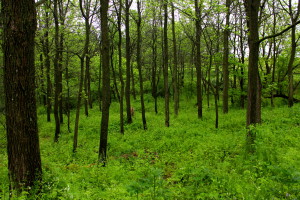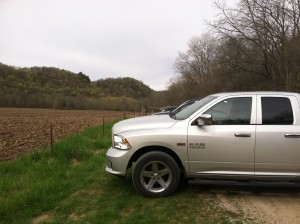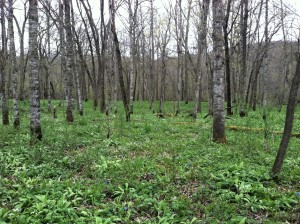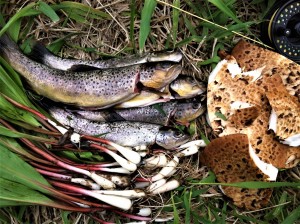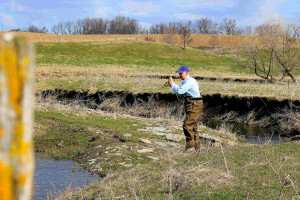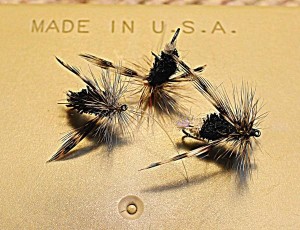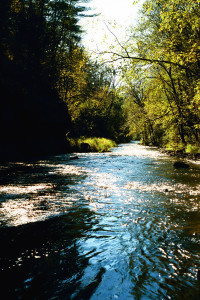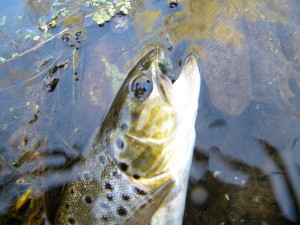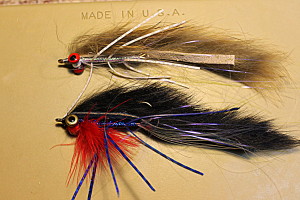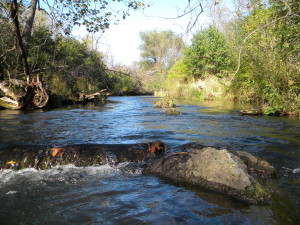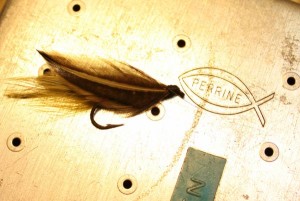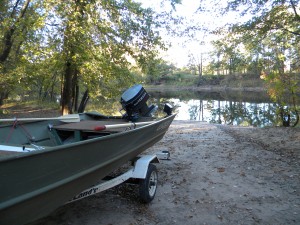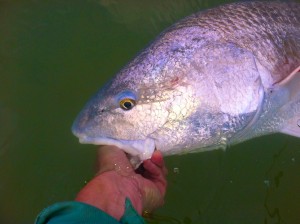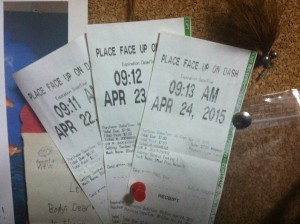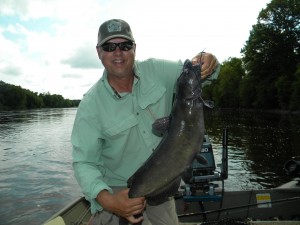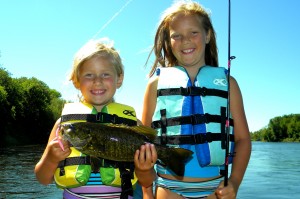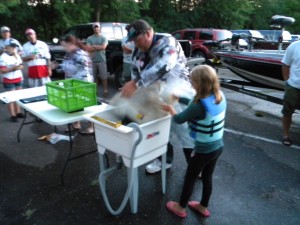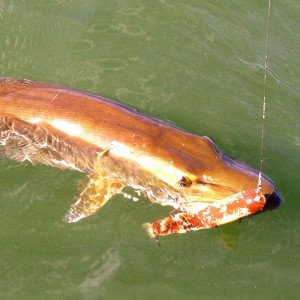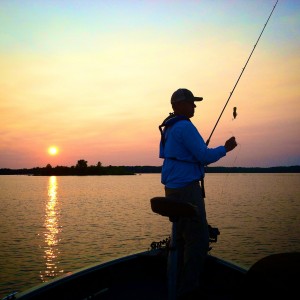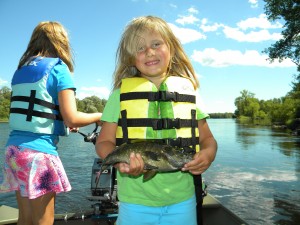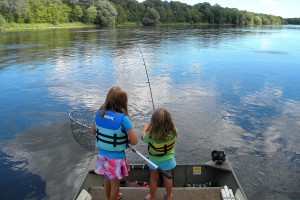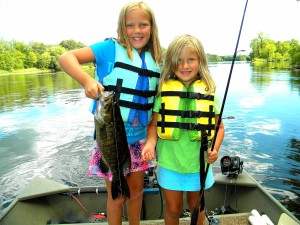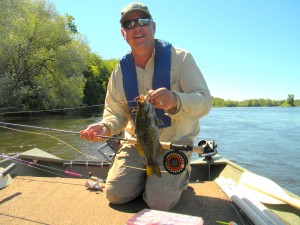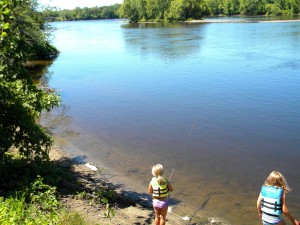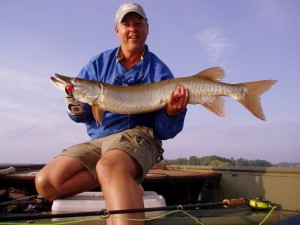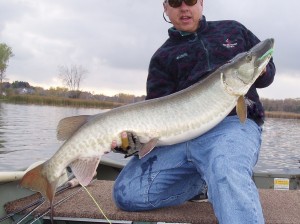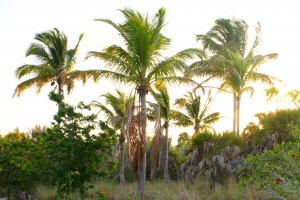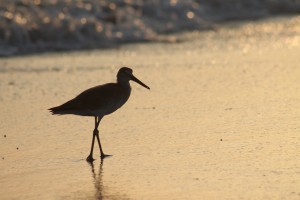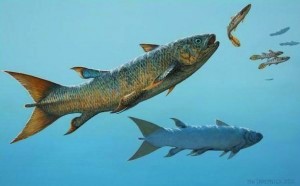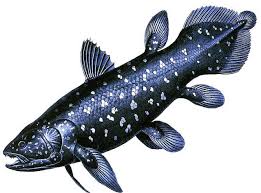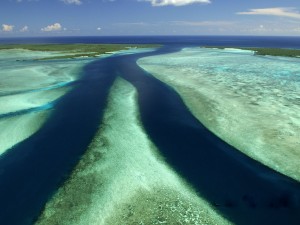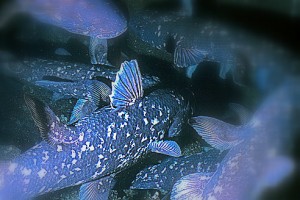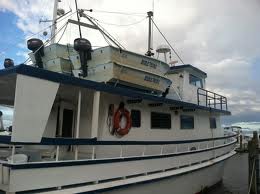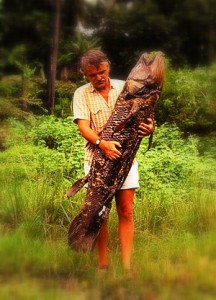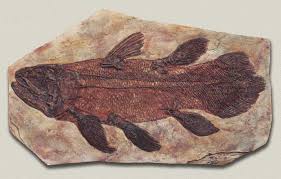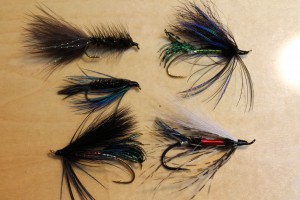Well I only harvest some—Neil Young, from “Harvest”
There is something about the descent into a trout valley in Southeast Minnesota that puts me in a good mood like few other things can. I started my journey on Saturday with the hopelessly boring drive on the highway south of the cities. The only thing of interest is the occasional stream that is passed over; I make sure I’m in the right lane at every stream crossing so I can get the best view of the water below, helping to get a gauge on the overall water conditions for the area. I hit Rochester and find it to be more of an annoyance than anything [better watch your speed, cops have someone pulled over every time I’m though on 52]. At some point I get off the highway, at least now there are some interesting old farms and other curiosities but it is still a bleak landscape, painted by someone whose palette doesn’t go beyond gray and tan. Then suddenly the road is pointing downhill. Down a steep hill. The colors spectrum changes from mostly gray to mostly green. Usually as I get close to my fishing destination my speed increases in anticipation of getting there, but today I find myself riding the brake though the valley as I try to take it all in. There are several streams that come together here, and there are many people out enjoying the great day.
My destination is a stream I have not been on before, and actually had very little info on other than some very limited second hand accounts. One key feature is that it is lightly fished due to lack of access points. I had Google Earthed the crap out of this stream, and the parking spot I was looking for was easy to find. I was disappointed that there were three other cars there. One vehicle had three generations of trout anglers about to head up the trail, they shared a bit of info with me, assuring me I would like what I found up in the valley. I was probably five minutes behind them on the trail, but they were nowhere in sight. The trail paralleled the river which was a few hundred yards away. Eventually the trail and river converged, and there were my buddies form the parking lot. I quietly slipped past them, walked hard for about ten more minutes and decided to start fishing.
When I’m on a new stream I fish very poorly. Or at least very quickly. I had no way of knowing exactly what was around the next bend, where the best water was, or where any other anglers were. Having fished a lot of streams I have learned that all trout streams tend to “behave” in a similar manner, which means that the ways that pools and rifles are arranged on one stream will likely be repeated on a completely different stream. The stream had a strong “Lower Kinni” vibe. Part of this was likely due to the hike up the valley, but there were a few riffles that had a twin on a different creek a hundred miles away.
What flies worked the best here? I had no idea. As is usually the case, I had a black wooly bugger tied on from the last time out, and I made a few casts with it, but my MO on this type of water is to nymph my way upstream, and then bugger my way back. So, I changed up with a nymph and a cork but continued to fish fast. There was so much good looking water here that I just couldn’t slow down. I would make a half dozen casts into “the juice” [this is Gunnar’s name for the “spot-on-the-spot”, as in “Quit casting into that bullshit water and throw into THE JUICE!”] and then march on to the next spot. It is hard to describe what the juice looks like, as it is different in each riffle or pool, but anyone who is an experienced angler will know what I mean. It usually involves an edge near the top of a run where the riffle comes in, where the current speed and depth are just right. I found myself constantly alternating between looking back over my shoulder, anticipating other anglers coming upstream and straining to see what was up ahead. Eventually I started catching fish. Not sure if it was because I had slowed down, found the magic fly [I was using a one-of-a-kind beadhead thing], or if I just got into better water, but this stream appeared to be filthy with trout. Most likely looking water would give up a few, and in a couple of spots I left them biting. I got to a point where the tasty water changed to flat “gator water”, and I figured it was a good point to stop and start fishing back. A break was in order, and I took my time eating a sandwich on a grassy bank. I thought about how glad I was to be fishing alone this day. I had asked my kids if they were up for trout fishing, but the response was less than lukewarm. I had considered trying to hook up with a friend this day, but my schedule is unpredictable, and I never know what I’m going to want to do, or where I’m going to want to go. Getting someone to put up with my unpredictability, and is willing and able to keep up, will have their own gear, know how to use it etc. is tough. I like fishing with others, especially on known water, but on this day I was glad to have all the adventure to myself.
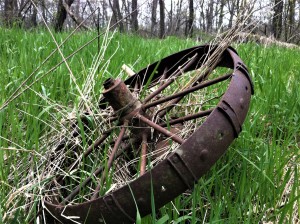
Despite all of my marching and fish catching, the spectacle of a mature hardwood forest on a spring day was not lost on me. The forest floor was a green carpet speckled with millions of white flowers, reminding me of stars in the night sky. I was wishing for a camera better than what is in my phone, but it would have to do. I was keeping an eye out for morels, but never did find a single one.
There were quite a few Pheasant Back mushrooms sprouting from dead logs though, and I decided today was going to be the day I would harvest some. I could already imagine cooking them up along with the five trout that I was quite sure I would catch on the way back downstream. And I figured I should dig up a few of the millions of ramps growing in the forest while I was at it, these wild relatives of onions were another thing I had never harvested before. [note to self—put a small shovel in your vest for ramp digging detail, digging them up barehanded is tough and dirty]
Sandwich eaten, bugger tied back on, let the trout harvesting begin. This stream has special regs like many other Minnesota streams, and there is no kill between 12 and 16 inches. The best ones for the pan are in the 9 to 11” range anyway. First cast- twelve incher, about as big as I had seen in this stream. I let it go, and was soon hooked to another, maybe a bit smaller. I put the tape measure on it to confirm it was under a foot, and it went in The Sack. The Sack is a mesh bag that mostly stays wadded up in the back of my vest, once in a while it gets to carry some trout. Soon there were a couple more in there. Funny thing, when I start fishing for trout that I’m going to keep it starts to be not as much fun. When I’m catch and release fishing [which is most of the time] and one gets away I don’t really care at all. When I’m keeping fish and a “sacker” gets off just as I’m about to grab him I can’t help but get pissed.
A few fish started rising here and there, despite the fact I had hardly seen a bug on the water all day. There must have been something hatching, as many unidentified warblers and songbirds were picking things off as well. The trout were hitting the bugger enough to get me to put aside any thoughts of dry fly fishing, but at some point they started coming up steady enough to get me to make the switch. The only bugs I had seen were a few caddis, so I put on the old trusty Henryville Special. They couldn’t get enough of it. At some point The Sack had five trout in it, and I stopped fishing to clean them in the style of my grandpa. He always gut and gilled his trout streamside, and I mostly keep the tradition alive, I have a little knife in my vest that is used only for this purpose. I figured that doing this was probably illegal, but then continuing to fish with a limit of five in The Sack probably is too. I took my chances with both, finally ending up in a run with 50 trout rising along the far bank. I did a time check as I got to this spot, knowing I was now at the point where I was going to be late getting home. How late was still debatable. After tormenting another dozen fish I decided enough is enough and I began the march back to the truck. I sent a text home indicating I was walking out of the valley. The hike out took about a half hour.
Epilogue:
I cooked the trout as I always do, de-headed and de-finned, but otherwise whole, pan fried. I chopped and sautéed the wild mushrooms and ramps and mixed them into some brown rice for a great accompaniment to the trout. Wild trout, wild mushrooms and wild veggies, all harvest from the same verdant valley. Sometimes life is pretty good.
There was one trout left, which I ate for breakfast this morning with more ramps and over-easy eggs.
Dream up, dream up,
let me fill your cup…
]]>
She had me there. “That’s true”, I said, “but this guy seems way less douchey than most, and even though I’ve never met him, we do have mutual friends…I think the guy might be a cop or something, and judging by his blog I’m pretty sure he’s harmless. The guy is always putting up pictures of big trout, which is more than I’ve been able to do this year. But…..if you don’t want me to go, I’m sure Gunnar would be up for going steelhead fishing this weekend…and Gunnar did say something about a new strip club opening up, we’ll probably check it out on the way home…”
Fast forward to Sunday morning at Eddie’s house. I really needed to break this trout fishing jinx.
I had left the decision as to where we were to go up to him, which is a very odd move for me. But I’ve seen his posts, he fishes a lot, catches plenty of above average sized trout, so I’m willing to trust his judgement. Besides, all of my best spots have been marginal or worse this year. He said bring a life vest in case we use a canoe, I wasn’t sure if he was serious or not, but I brought one with to be sure. I wasn’t even sure which state we would be headed towards, so I made sure all licenses were current in the five-state area, and I brought my passport just in case he had some crazy Nipigon mission in mind. I was just hoping to get into some good trout fishing, and after a quick chat in his kitchen we had the canoe loaded up and were off.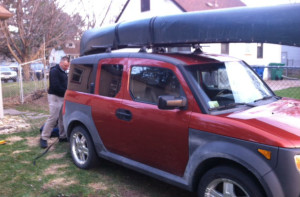
We had a great talk on the way to his first spot, talking of places we’ve been, mutual people we know, that sort of stuff. He’s been at the trout fishing thing for about six or seven years, and has a crazy exploratory nature. He writes a blog that I enjoy, a lot of you have probably seen it — Eddie Rivard Fly Fishing
Even when I used to fish a lot more than I do now I didn’t explore like he does. It later occurred to me how much easier it is today to seek out new spots with all the info that can be gleaned off the internet. It became pretty obvious early in our conversation that there were no trout spots I knew of that he hadn’t fished and probably caught an 18 incher out of. He did make a comment about how he had not been able to figure out where “Area 51” was, even though there were power lines in a photo of me with a trout there. “Area 51” is a Triple Secret Spot of mine that very few people know the exact location of, and I couldn’t remember even posting a picture where I named the spot, but it amused me to learn that I was not the only one that would spend hours on google Earth trying to figure out where someone’s fish picture was taken.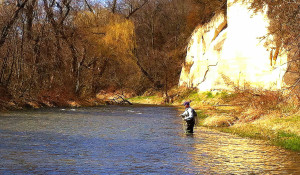
Our day ended up mostly being a series of what I would call “hit and run” spots—park, hit a couple of “money spots”, then back to the vehicle. The first spot we tried had the water pretty high and muddy, not quite what I would call unfishable, but getting there. I hooked up right away on a nice twenty-incher, which turned out to be a redhorse. We never decided if it actually ate my streamer or just got snagged in its ample upper lip. No sign of trout, but it was cool to be fishing on water that while it may not be completely secret, it was totally off my radar.
We had a quick look at this unknown creek, Eddie couldn’t resist making a couple of casts right by the road
We bopped around and tried a few more spots, but Eddie eventually decided we would need to find some clear water. And clear water we found. We ended out our day on a pretty little creek with an abundant population of little trout, and even they proved to be too much for me. Eddie assured me that he had tangled with some big fish in the creek before and I believe him—there were numerous undercuts and hidey-holes where a big trout could live, just waiting for the next fingerling trout to munch.
So the jinx continues.
I keep saying how good our local trout fishing was in the 90s. If you weren’t around then, imagine this—The Rush is thick with fat browns, mid teen to low 20 inch fish were common. The Upper Kinni had over 5,000 trout per mile, and the lower had great numbers of 10-16” browns, and it always seemed like there was a hatch. And no kayakers floating over your fish. Even the Willow had a strong population of trout of all sizes, you could even expect dry fly action most evenings. There was no internet, no Google Earth, no place to post your reports. Maybe at the local fly shop, but that was about it. When Eddie asked me if I had ever fished this spot or that spot, I always had to say no. The fishing was so good on the home streams that there was no need to explore. And every time I did go on a mission to the Eau Galle or the Trimbelle or some other similar spot I always had the same result—nice streams, there are fish to be caught, but it just didn’t make sense to drive by miles of the best trout water in the Eastern US to explore.
I keep saying that the streams will come back, and they will. But for now it appears that exploring is necessary. There are more good anglers, and less secrets. In the 80s and 90s the vehicles I had were unpredictable at best, and more than once found me broken down somewhere. Vehicles today are all good, I never see any beaters parked at the streams, or anywhere else for that matter. A vehicle that is reliable and gets good gas mileage may be the best piece of trout equipment there is. Match it up with high speed internet to access resources like Google, the USGS Streamflow Gauges, and DNR websites, there’s no good reason to not be able find somewhere to fish. So I guess I better get busy and find me some good water to fish. I’ve got a milk run in mind, this weekend or maybe next.
And remember that even the best vehicle won’t do you any good if you run out of gas.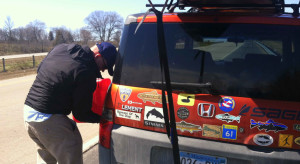
So Saturday morning found me and Savannah heading South on Hwy 52, hoping to put together a good day of troutin’. Rain was threatening, but after studying the NWS radar I convinced myself that it would rain little, if at all while we were out. Savannah has caught a bunch of trout before, but it has always been on bait. I was hoping to take it up a level, and I had put together a small pocket box for her with a few Rapalas and Panther Martins. The drive went quickly and any fears of the streams being blown out were for nothing as the water was clear, maybe too clear.
Savannah is a capable caster for a nine year old, but casting in a small stream is challenging, and accuracy is crucial.
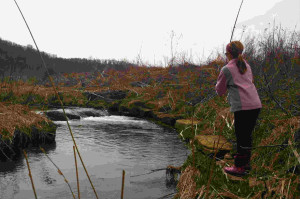 She did pretty good though, and hooked a nice fish in each of the first two spots we tried, but both came off right away. How a fish can avoid getting caught when it bites a Rapala remains a mystery. There were some small trout rising steadily in a couple of spots, and I was able get them to bite without too much difficulty on any small fly I showed them, but I really wanted the girl to get one.
She did pretty good though, and hooked a nice fish in each of the first two spots we tried, but both came off right away. How a fish can avoid getting caught when it bites a Rapala remains a mystery. There were some small trout rising steadily in a couple of spots, and I was able get them to bite without too much difficulty on any small fly I showed them, but I really wanted the girl to get one.
I’ve not done much spin fishing for trout in the last 30 years, I did a lot when I was a kid, though. I learned early on that when the Rapala/spinner bite is on, it can be ridiculous how easy it is to rack up a bunch of fish. [Sidebar—At some point I realized that when the Rapala bite is on, the streamer bite is also on!] But when the trout are not on the Rapala program, you have to cover a lot of water for every bite. 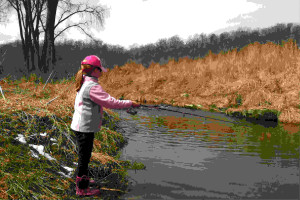 This seemed to be the case today, and I’m sure the snow melt, while not causing the water to become muddy certainly cooled it off enough to stop the trout from being in a chasing mood. We broke for lunch [cold pork chop for me, bagel with strawberry cream cheese for Savannah] and made a fresh attempt, this time heading upstream from the bridge. I scored a few more on a Griffith’s gnat, and I hooked up a nice brown on Savannah’s Rapala out of a particularly narrow and snaggy run that she didn’t want to attempt casting at, and quickly handed the rod off to her. It was about 13”, and seeing the fish renewed her interest in getting one on her own.
This seemed to be the case today, and I’m sure the snow melt, while not causing the water to become muddy certainly cooled it off enough to stop the trout from being in a chasing mood. We broke for lunch [cold pork chop for me, bagel with strawberry cream cheese for Savannah] and made a fresh attempt, this time heading upstream from the bridge. I scored a few more on a Griffith’s gnat, and I hooked up a nice brown on Savannah’s Rapala out of a particularly narrow and snaggy run that she didn’t want to attempt casting at, and quickly handed the rod off to her. It was about 13”, and seeing the fish renewed her interest in getting one on her own.
We decided to head back to a big corner hole we had tried in the morning, and she covered every inch of it with spinner and Rapala without a bite. While she was doing this, the trout were rising steady at the top end, gorging themselves on some mayflies that were hatching. I made a few casts with a dry while Savannah was changing lures, and hooked one on almost every cast. Savannah has caught a few sunfish on flies, but we’re never tried it on trout. It was obvious if she was going to catch a trout today it was going to be on a fly. So we repositioned ourselves at the top of the riffle, where a short cast would put the fly over many rising trout.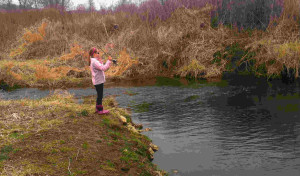
I told her that it was no use to try to learn how make a good and proper cast while there are trout rising almost under your rod tip. “Just do what you can to get it out there”, I said, and that what she did. The casting form was bad, a couple flies got snapped off, and many strikes were missed. BUT—two trout were brought to hand, she made the cast, hooked the trout, and brought them in herself. None were large, and they had probably spent their lives up until a few weeks ago in a DNR concrete raceway, but we didn’t dwell on that.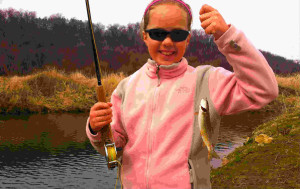
Here I had hoped she would catch a fish or two on spinning gear, instead she ended with a couple on flies!
]]>
It troubles me that I am going into this trout season with a genuine lack of enthusiasm. I’m still looking forward to walking the creeks, taking in the sights, sounds, and smells, but I just know the trout catching is going to be off. For reasons I’m not going to get into here, my two favorite streams [the Upper Kinni and the Willow] are seriously hurting in the trout population department, and it’s going to be a few years before it improves. So for catching, that leaves the Rush, or maybe the lower Kinni. Not that these are bad—quite the contrary, these are fantastic streams with wild trout and fishy riffles and pools. Also an abundance of trout anglers, [and %$##&@ kayaks on the Kinni] and I hate the fact that when I’m approaching a favorite access point I have to start deciding how many other vehicles I will tolerate. More than three or four, I’m off to the next spot. This is why the other creeks have been so dear to me, enough fish to keep me busy, and always plenty of water devoid of other anglers.
I know my favorite streams will come back, but in the meantime I’m going to share a few times when the fishing was truly outstanding. I’ve had a lot of great days on the local creeks, but these are some days that really stand out. Interesting to note that my very best, most memorable days were days I was fishing alone.
The first year of the “Early Season” [the one that would start March 1] was a great year. I really fished a lot in those days, and two extra months equated to a couple hundred more trout than before. I was on the Upper Kinni, it was March 20 [I forced myself to remember the date], and I think 1997. I’m working through some favorite water with the trusty UV scud tied on, when out of nowhere there is a very aggressive rise just above me—like someone threw a baseball in the water. Not one to switch to a dry at the first sign of surface activity, I kept dredging, and was catching a few. The big splashes continued, and were becoming a distraction. I stopped casting to try and determine what was happening. I had seen a couple of bugs flying around, but hadn’t really paid much attention to them. I soon realized that they were black stoneflies—they were starting to buzz on the surface, and I spotted a few crawling on logs. I looked up to the top of the run I was working, and here comes a stonefly buzzing down the center of the stream [they lay their eggs this way]. SPLOOSH—the bug gets chomped by a better than average trout, and I couldn’t get the nymph, shot, and cork off my leader fast enough. As I’m cutting off my nymph rig I am taking a mental inventory of all my fly boxes, trying to picture what I have to be a suitable stonefly imitation. Remember, this was the first year we could fish there this early, and no one was aware that the black stoneflies were such a thing on the Kinni. A big elk hair caddis would have to do, and I greased one up with floatant after it was tied on, and after a couple of quick false casts it was drifting toward where I has seen the last fish feed. It hadn’t floated a foot before it was eaten, and I was soon admiring the first of many trout I would catch that day. I didn’t count them [I always lose count after 2], but by mid-afternoon I had caught more than enough and headed home early.
Since this memorable day, I always try to get over there on a warm, sunny day around March 20. I have hit this hatch pretty good a few times since, and I have designed a very devious stonefly pattern specifically for it. It takes about 20 minutes to tie, but it looks really good. And it works exactly as well as an elk hair caddis that I can tie in about 3 minutes.
here’s the pattern:
Hook: TMC 100; Butt: Pearl Litebrite; Body: Clipped black deer hair; Hackle: Grizzly; Wing: Grizzly hackle tips
These bugs have what appears to be a glowing white egg sac on their butt when laying their eggs
Thinking about this day reminds me of another epic dry fly day on the Kinni. This time I was headed to the lower river, and as I crossed into Wisconsin I was anticipating my hike up the canyon from County Road F. It was midweek, so I wasn’t worried about crowds or kayaks, and I expected to have some decent nymph fishing before some mayflies would start hatching in the afternoon. I don’t remember the date, but it was around late May/early June in the early “Oughts”. [I’ve been dying to say that]. I’m not known to be a particularly fast driver, but my speed definitely will pick as I get closer to a stream. I was moving right along at about seventy, anticipating a great day. I’m always hoping for a good “inspirational” rock anthem to come on the radio to really get me fired up as I approach the stream. On this day, Rock and Roll [part 1] by Gary Glitter came on just as the old white Chevy began the descent into the valley. I cranked it up and cheered at the right parts until I pulled into the parking lot at the bridge. I’ve made this hike enough times to know that it involves about 45 minutes of steady hiking to get to where I start fishing. There is a long bluff pool with a great riffle that comes in at a sharp angle at the top. Similar to my previous story, I started out nymphing, and they were really hitting it good. I can still remember one that ate the fly and started jumping before I was even able to set the hook.
I fished all the way to the top of the riffle, probably caught a half dozen. I had been noticing some fish rising a bit upstream. I was keeping an eye on them as I headed up the path, and decided to sit on a big log laying across the stream and eat a sandwich while I watched the fish rise. There were some mayflies coming off, I think it was the light Hendrickson hatch, and as I paid closer attention I could see that the next riffle was ALIVE with rising trout. I was grinning a grin while I ate my sandwich, watching those trout rise, thinking about how many I was about to catch.
This next riffle where the trout were making a spectacle of themselves was really nothing special to look at. A small riffle came into a little run along the right bank, there were a couple big rocks, and it was maybe three feet deep tops—definitely not a spot you would think could hold more than a few trout. Despite the fact that it looked like a marginal spot at best, there appeared to be at least a dozen trout rising steadily. I had re-rigged while sitting on the log, I now had a trusty comparadun on my tippet, greased up and ready to go. After stepping in, I was hooked up within a couple of casts, and then almost every couple of casts after that. I can’t remember how many I pulled out of that little run, but it seemed like for everyone I caught, two more took its place. It really was bizarre, because it just didn’t seem possible that there could be that many trout in there, but no matter how many I caught, they just kept rising. I finally decided to move on, and every likely spot was the same—seemingly unlimited rising trout. They rose steady though the afternoon, and I never saw another angler. Throughout the day I changed flies regularly [I had to, they kept getting waterlogged from all the fish!], and I tried a little bit of everything. This confirmed to me than when trout are rising to mayflies, you just can’t do better than a comparadun. I caught some on other designs, but nothing worked better. It didn’t even seem to matter if it was the right color or size either, as long as it was a comparadun.
It was getting later in the afternoon, and I was working my way up through what we call the “Bread and Butter” run. There were trout rising all over the place, and I was catching them steady. I looked at my watch and it was 5:30. I decided I would catch five more and leave. I forced myself to keep track of the next five I caught and then I looked at my watch again. It was now 5:40. I made a few more casts, caught one more, then had a smoke while I watched them rising for another five minutes. Every run and riffle that I walked by on my hike out of the canyon had trout rising in it. I have never seen a river so alive with trout. How many did I catch that day? The rate at which I caught the last five were representative of how the action was all day, so figure conservatively 20 per hour for five or six hours.
The Willow River has long been my favorite stream. Light pressure, easy access, and while the trout population has never that impressive as far as numbers, due to warmer water and abundant forage, the average size can be impressive. And this was the case on a fine spring day sometime in the late 90s. Or early Oughts, I don’t remember. Rarely a place for good dry fly action, the Willow’s dark waters are better suited for dredging big wiggly nymphs or swinging bunny strip streamers or buggers. I had my favorite 6 weight rigged with a clear tip line. The clear tip is slow-sinking, and provides just the right amount of sink for the streams around here, and it allow for the use of a shorter leader for better accuracy when casting at close range around bushes and other cover. When the streamer bite is “on”, the exact fly hardly matters—what matters is that you cover water and show your fly to as many fish as possible. I was using a favorite pattern that is really nothing special. I call it the “Strip Club”, it’s got a bunny strip, lead eyes and some rubber legs. I tie this fly [and many other trout streamers] on a 4x long streamer hook, size 4. This is more important detail that what the pattern was, or what color the fly was. This hook is just the right combination of length and wire thickness for a trout streamer. [This is a also a good fly for steelhead and smallmouth.]
Hook: 4XL streamer; Tail: Flashabou; Body: Sparkle Braid with 3-4 sets of rubber legs; Wing: Bunny strip; Throat [optional]:Contrasting marabou; Eyes: Medium lead eyes
There are many days on this river when I might get a fish out of every 5th spot. This day, every big fish in the stream wanted to play, and by the time my session was done I figured I had had landed around 18 fish. I know, not exactly insane numbers, but the funny thing is the one I remember most was the smallest one of the day, and it was a foot long. I chuckled when I released this guy, ‘cause he was just a baby compared to most of the other ones that day. I don’t think I had any others under 15 inches, most were 16- 18 inches, and a couple were over the 20 inch mark. These were serious, “put-’em-on-the-reel” browns that could have just as well been measured in pounds. Not bad for a stream 30 minutes from St Paul.
I have had other great days on the creeks over there, and I hope there comes a day when it is again possible to have a “big day”. And to be fair, I have plenty of great memories of trout fishing where the things I remember most wasn’t the fish catching. For some reason this memory just popped in my head—I was over there with the Gunnar, we hadn’t brought any food with us [SOP in those days], so we subsisted on berries we picked along the stream. At one point we were both sitting on the ground off the trail, chowing all the wild raspberries we could reach. We probably caught a few trout.
EPILOGUE
I fished on the Wisconsin creeks the other day, it was pretty warm but windy. I visited the Rush for the first time in a few years. First thing I see is the Red Barn Cafe has turned into a Bar and Grill. Figures. What happened to the big metal bridge? I guess some would have called it ugly, the cement one that took its place is sure nothing special. And most importantly, where did all the trout go? I know there are trout anglers more skilled than me who are catching some fish there, but seriously—I can remember being there when a hatch was on and walking right by a riffle full of rising fish if there weren’t any big heads popping up. On this day I was “zero for zero” after nymphing through a bunch of good water that I have caught hundreds of trout out of. All I caught were a lot of memories as I walked up the canyon. I could tell stories about every pool in this section. Stories of fish caught, of people I was with, of bugs that were hatching, of big trout seen and big trout caught. There was a guy much younger than me working a streamer through the bottom end of a deep pool. I really wanted to tell him about the time when I was 15 and caught a 16” brown on a black ghost streamer around the boulders at the top of the pool. I wisely just asked how he was doing as I walked by on the well-worn trail. “No fish on the streamer, might try nymphs”.
This is the very Black Ghost streamer, my grandpa tied it in around 1980, and it has lived in my Perrine fly box since. He used jungle cock saddle hackle for the wings, the fly is about 2-1/2 inches long
I finally came to a canyon pool where there were what were obviously tiny trout rising to tiny bugs. I looked at them dimpling, and shuddered that it might come to fishing for them. I fished my nymph rig through the fast water at the top and then down through the meat of the run against a bluff with a few logs thrown in for good measure. Didn’t get a bite, and since the dinks were still rising I reluctantly re-rigged with the smallest fly in the box tied on to some ancient 7x tippet.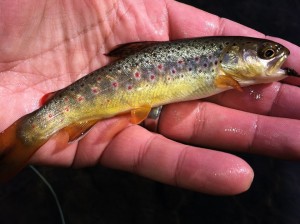 I have never been so glad to land a five inch trout as I was when I brought in the first of a half dozen or so. At least I wasn’t skunked. I did catch one brook trout that was maybe 10 inches, and broke of a slightly larger fish. [I was using tiny flies on a 7x tippet, and the only 7x I had in my vest was some Seaguar that I KNOW has been in my vest since the 90s.]
I have never been so glad to land a five inch trout as I was when I brought in the first of a half dozen or so. At least I wasn’t skunked. I did catch one brook trout that was maybe 10 inches, and broke of a slightly larger fish. [I was using tiny flies on a 7x tippet, and the only 7x I had in my vest was some Seaguar that I KNOW has been in my vest since the 90s.]
I left the Rush to try a favorite “hit-and-run” spot on the Kinni, caught exactly zero. Drove to the Willow, not really planning to fish, just to “have a look”. I took one look at the water and knew it wasn’t going to happen. As you may know, a dam was removed last year and this released a lot of sediment. Now the Willow, not known for great water quality anyhow, was flowing a sickly greenish grayish tan color, with less than a foot of vis. The Willow hadn’t been fishing well for me for the past two years, I don’t know what to make of this. It will be a while before I go back.
Don’t get the impression that I’m only concerned with numbers of fish—I enjoy steelhead and muskie fishing, neither of which is known for non-stop action, and I’ve had plenty of nice days on the trout stream where I only caught a few fish. I’ve just become accustomed to being able to have at least steady action on these streams. Some days, steady may have meant five or more an hour. Other days is might mean one ever two hours. But I am hoping for some version of “steady”.
Any of you out there that have been fishing the local creeks for more than a few years must admit–we had it good. Those streams being what they were for the last 40 years really have a lot to do with who I am. There wouldn’t be four fly shops in the Metro Area if it weren’t for how the streams used to be. And I know things are cyclic. It may take a few years, but the streams will come back.
I do know that I will be learning some new trout water in Southeastern Minnesota this spring!
]]>It seems like I’ve got it in my head that 2015 was a terrible fishing year for me. As a dad, a homeowner, a landlord, an employee, and an actual grownup, I sure don’t have the time to get out like I used to. Although part of that is that I don’t NEED to catch fish like I used to. What the heck, Wisconsin trout season just opened, and I haven’t even considered going, and probably won’t for at least a month. The fact that favorite trout stream went to crap doesn’t help, but more on that later.
And for someone who doesn’t “fish that much anymore”, I sure do fish a lot. I was explaining to an old friend, “It’s frustrating to not get out much anymore. I only made it out one night last week, and only one half day on the weekend. I did go on a short trip out of town the weekend before that, but otherwise…” Now I notice my friend has a WTF look on his face that says “You still fish more than anyone I know”.
Fish smarter, not harder might be my mantra now. I don’t do a lot of exploratory stuff anymore, and really try to focus on what I can depend on. But I somehow still manage to add some new spots to the lineup, which is good because some old favorites have been way off. The more you fish, the easier it is to stay on them, and its easier to decide when to make a move if you have plenty of spots to make a move to.
Here’s where we launched for smallies one fine day this fall, based on a tip from a friend. It was a good tip.
My fishing season usually kicks off in early March, chasing trout on favorite Wisco streams. It’s no secret now that the trout numbers are WAY down, populations have suffered from a few long cold winters and some big floods. Last opener I managed only a few fish on my first trips, but one was a full sized 20” brown.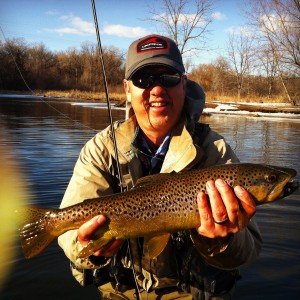
Next on the itinerary was a trip to Sanibel/Captiva, one of my favorite places. Besides going out with a guide one day and renting a boat one day,I got out at dawn a few mornings to harass the snook and stuff that live there and ended up having good fishing each time, and one morning was really great—seriously one of the best fishing sessions I’ve ever had ever. Some big snook, a redfish that was ridiculous, and I didn’t get eaten or even gnawed on by a shark or alligator. A manatee came up so close to me that I was able to poke it with just the tip section of a 3 piece fly rod.
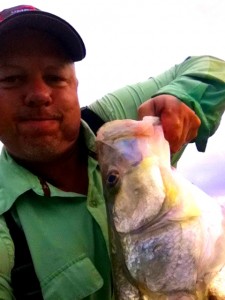
I kept my parking receipts from each morning, the time shown was how long my parking was good for.
May saw the beginning of the end of a favorite bass lake—Little Falls Lake was drained last year. I got in one last session there in the float tube. It looks likely to me that the dam will be rebuilt and the lake will fill back in, but I have to believe it will be 10 years or more before the fishing comes back to what it once was.
Summer means smallmouth on the Mississippi, but for reasons I’m unsure of, this was not fishing well this year either, at least not in the Monti stretch. There were fish to be caught for sure, but you had to work for them. A big catfish was my most memorable catch from there this year.
I did take the girls on a camping/fishing trip later in the summer, we had a fine time in the Royalton section. We’re looking forward to doing it again this year.
Savannah is my partner is a series of bass tournaments each summer. When started this two years ago I made it clear that we didn’t have to win…but we definitely don’t want to lose! The first year we did pretty good, always came in with a nice bag and were even in the money once. This past year, ugh. I’m not sure what happened but we just couldn’t get it together. This year will be better, I just have to convince Savannah that bass can be caught in places other than under docks.
Here is Savannah weighing in our bag at South Center Lake.
One perk of working in the fishing business is that once in a while you can actually be on the clock while fishing, usually under the guise of product testing, team building, or some other BS. One such day I was testing out some new equipment for my company on White Bear Lake. When I had done all the testing that was needed I found I still had an hour before I needed to be anywhere. It was hot and sunny and calm, not ideal fishing weather, but I somehow ended up with a full-sized muskie on the line in less than ten casts. I also got a phone call that day that was a job offer, and it is with this new company that I am presently employed. So to summarize this day– 1. Got paid to be out on the water. 2. Caught a big muskie. 3. Got offered a new job. I guess this was a good day.
There were other fish, there were great times spent on the water with family and friends. Agates and mushrooms were found. Fish were kept and eaten. There were sunrises and sunsets, campfires, canoes, kayaks, seashells, loons, lady slippers, waterfalls, rivers, streams, and lakes. I wanted to just mention a couple of highlights, I find myself wanting to add to what I’ve already got here. Now that I really look back, there may have been somewhat of a shortage of fish that were caught, but there were as many good memories as a person could ask for.
One friend tells me I am definitely living the dream. He may be right–I have a great wife, two kids, two boats, a house, a job, and I do get to fish a fair amount.
Here’s to 2016, which I see is the year of the monkey. There must be a joke here somewhere, but much like a school of 4 lb. largemouth, I just can’t seem to find it.
]]>Like most parents, I want my kids to like what I like, and if I bribe them to play along, does that make me a bad parent? If so, better get CPS on the phone, because a day of fishing with dad is likely to end with a stop for ice cream. But a camping trip was going to need an extra special level of bribery.
As it turns out, Savannah did go on a camping trip with me two summers ago. It was touch and go for a while when a seriously bad storm rolled through our campsite on the shores of a remote lake. It really was bad, but we made it through it OK, just a little soggy. Savannah still gets nervous thinking about that storm. On our way home, we stopped in Royalton at one of Minnesota’s best known tourist traps and I let her pick something off their crowded shelves of treasures.
We drive by this store every time we go to Grandma’s house, and Savannah will generally remind Skylar of how she got to stop there, how great it was inside there, and don’t you wish you could go there. So my bait to get them to go camping included a stop at Treasure City. It so happens that there is a nice campground on the river right there, so plans were made, and on a fine July morning we pulled into the Sportsman’s Club Campground.
Since this was midweek, I wasn’t too surprised to find a lot of empty campsites, so we chose a site right on the river near the boat launch. A nice breeze coming off the river assured the mosquitos would stay away, and we had our tent set up in ten minutes.
My camping gear consists of a tent, sleeping bag, a lantern, a folding chair, and an axe, so I’m faring a little better than the folks on “Naked and Afraid”. I don’t have any camp cooking stuff, most of what cook in camp involves either aluminum foil or a stick. 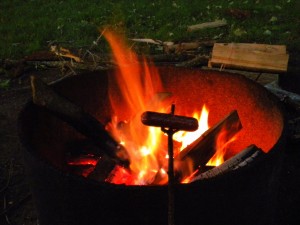 Hot dogs are far from being a favorite food, but I like to keep it simple, less time cooking = less time cleaning = more time doing other stuff, like fishing or relaxing around a campfire.
Hot dogs are far from being a favorite food, but I like to keep it simple, less time cooking = less time cleaning = more time doing other stuff, like fishing or relaxing around a campfire.
So camp is set, boat is launched, and we’re now heading upriver. This is a section of the Mississippi I had only been on once before, my memory of it was good fishing, but shallow and pretty treacherous for a prop boat. The other time I was here I ended up having to walk the boat up through a particularly shallow stretch around some islands, and after studying the area on Google Earth I decided that a different channel would allow for easier passage. Wrong. I have often been in the predicament of trying to get through too-shallow water, when faced with this I will have my boat partner get all the way up to the bow—this will raise the transom up, giving a little more clearance. On this trip my boat partners weigh about a hundred pounds between them, so not much help there. Ended up having to walk the boat up though about 100 yards of knee deep water again, and dinged my prop a few times when I was trying to push my luck. They did offer words of encouragement as I muled the Jon boat up through the shallow riffle. 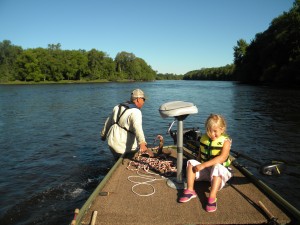
Besides catching smallmouth, we have one other activity: this section of the Mississippi is one of a few places on the entire earth where a special kind of stone called a “staurolite” is found. These are also called “Fairy Stones” or “Fairy Crosses” and you can bet I talked these up to the girls who are all about anything that has to do with fairies. A perfect fairy stone [I’ve only seen pictures of a perfect one] looks somewhat like a Maltese cross. It’s no secret where to find these stones, and as we approached the area I had learned about I could see there were several people in the area, stooped over and intently studying the gravel. I’m no geologist, but I couldn’t imagine why the stones would only be found on one side of the river, and since we had a boat we went straight across from the publicized spot. We found plenty of stones, but I think that finding a fairy stone that looks anything like an actual cross is pretty rare. Our best fairy stones are pretty boring looking at a glance, but it is interesting how they have a diamond cross-section. We also found some nice mica pieces. 
Once our rock hunt was over it was time to fish. We alternated between drifting and anchoring, and while the fishing wasn’t red hot, the girls each got a few fish. I had come up with a points system where various fish captured would equal dollars to spend at Treasure City. This did cause argument over who got to watch the night crawler rod while anchored, as the crawler was likely to produce fish other than smallmouth. We spent an hour anchored at one spot where smallies were aggressively feeding on damselflies. I have seen this a few times before on my home water, and usually have a few damsel fly patterns on board just in case. I took them out last week while consolidating fly boxes, so we just went through the tackle box, trying this and that. The biggest smallmouth ate a crawler, but most memorable was one Skylar caught on a crankbait she picked out of her tackle box. It was the first time she caught a bass on a lure where she made the cast and set the hook herself, and it while it wasn’t very big, I’ve never been more proud.
As the sun got a little lower, the action picked up, but the girls were a little spent. I fished some likely looking shorelines myself and put on a mini-clinic on how to catch smallies on soft plastics—caught about 5 fish and missed a few others before we had drifted back to camp.
When we got back to the ramp we met a gal who was about 3 weeks into a Lake Itasca to the Gulf of Mexico kayak trip. She had the world’s smallest tent, but seemed to have everything she needed, including a pink flamingo for a mascot. She looked just like someone I had met a few years ago doing the same thing, but when asked she replied “No one would do this twice!” A solar panel on the kayak kept her computer and phone charged. The strange thing to me was that she is from California, and I didn’t get the vibe she had even been to Minnesota before.
Here she is just before I gave her a shove and on her way down stream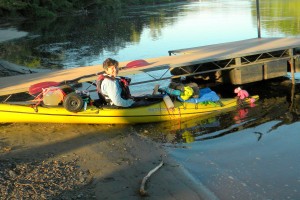
Our dinner that night was Easy Mac [turned out horrible, turns out you need a microwave for this kind of mac and cheese] and hot dogs. I had foil and butter with in case a walleye or pike was foolish enough to end up in the boat, but our species this day included smallmouth bass, channel catfish, and redhorse sucker. Skylar still can’t quite figure out why we eat some kinds of fish but not others. After our nutritious dinner it was time for a Minnesota campfire classic– s’mores—I even ate one. 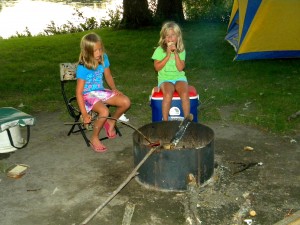 Finally the fire died down and it was time to turn in. We soon found that a huge emergence of stoneflies was going on, and they were EVERYWHERE, including in the tent. All of my explanations of how harmless they were fell on deaf ears, and the girls would not rest until all had met their demise by flip flop. After my stories of sasquatches in these parts on the way up, it was decided that the safest place in the tent in the event of an attack would be in the middle. Savannah [of course] claimed this spot for herself, and the girls watched a movie on their DVD player. The night was uneventful, no sasquatches, no yetis, not even a woodchuck.
Finally the fire died down and it was time to turn in. We soon found that a huge emergence of stoneflies was going on, and they were EVERYWHERE, including in the tent. All of my explanations of how harmless they were fell on deaf ears, and the girls would not rest until all had met their demise by flip flop. After my stories of sasquatches in these parts on the way up, it was decided that the safest place in the tent in the event of an attack would be in the middle. Savannah [of course] claimed this spot for herself, and the girls watched a movie on their DVD player. The night was uneventful, no sasquatches, no yetis, not even a woodchuck.
The following morning was the kind of morning we all hope for—a bit cool, but sunny and glorious in all ways. The girls were delighted that I had hot chocolate fixins, so I made a batch and got the fire going again. To keep the nutrition and chocolate theme going they had Cocoa Puffs for breakfast. I made them wash the few dishes we had while I broke camp, and then it was time to get back on the water. I backed the boat down to the ramp to let some water drain out, and a guy who was part of a party that had just launched a driftboat commented on how much water was coming out of my boat. “Well this boat has seen a lot of use and yeah, it has a slow leak, and because of how I had it parked last night the water didn’t drain out yadda yadda…and it’s only a couple gallons yadda yadda…” was my response. So I launch and tie up to the dock. Then I notice that the driftboat that the three guys had just launched was about half full of water. I pointed this out to the guy who had been so nice to point out how much water came out of my boat, and suggested he put the plug in. Well it wasn’t his boat, it belonged to one of the guys doing the shuttle, and he didn’t know where the plug was, and the yeti cooler on the dock wasn’t going to be much help for bailing. I had a spare drain plug, figured out where it went and grabbed a couple of buckets and we had it mostly bailed out in a few minutes.
By now, my girls were on the dock watching the show. We all got aboard, shoved off and wished the guy good luck. We headed off upriver to where we had caught fish the day before. It was mostly a repeat of the day before, no crazy fast action, but enough to keep everyone interested. They had a double header on at one point, the smallie Savannah had on was the biggest of the trip but it got away just as it got to the boat. Skylar caught one that ate an errant cast that landed 5 five feet from the transom while we were anchored in pretty swift current.
Note the custom pink worm Beetle Spin thing we put together that it ate
I even broke out the fly rod and managed to get one on a craw pattern.
We were in the home stretch, maybe a half mile from the ramp. The water was pretty clear, and I could see the bottom pretty well in five feet of water. When the conditions are like this I enjoy drifting along, spotting different fish. I was seeing a lot of fish that at first I thought were big redhorse, but I soon realized they were mostly catfish, and big ones at that. There must have been 50 in one short section, most looked to be 5 to 10 lbs. We were out of bait by this time, or we would have anchored up and exercised a few kitties. Next time.
Back at the ramp I pulled the boat up on the gravel and told the girls they should make some casts just below the access, as I had spotted a couple smallies there the day before. When I got to my vehicle, my buckets and drain plug were waiting for me, along with ten bucks—that was a nice gesture. I pulled the boat out, and after I had it strapped down I went to check on the girls. They were still casting, but hadn’t quite made it to the best spot, an area where there was a nice rock pile about 30 feet from shore. I had a great vantage from up on the high bank, and when I walked just a bit downstream, sure enough, there was a nice smallie patrolling the rocks, on the hunt for a well-placed Beetle Spin. I was just about to call the girls to the area when I spotted another fish out there—a muskie! Looked to be in the low 30” range, and would be sure provide a large amount of excitement if it was at the end of a little girl’s line. I had them take turns casting at it, they tried a Rapala and a wacky worm, but no luck, that muskie was having none of it and left for calmer waters. Then Skylar had a smallie nose right up to her wacky worm, I said “leave it…leave it…now give it a little twitch!” and she proceeded to jerk it about 4 feet, and Mr. Smallmouth went the same direction the muskie went.
You can’t see it, but there is a muskie 30 feet in front of Skylar
So now we were left with only one more thing to do—the promised stop at Treasure City. With all their fish they had each accrued $12 to spend, and they managed to spend most of it on knick-knacks. If you’ve never been there, it really does deserve a stop, the amount of crap they have crammed in there is impressive. Less than two hours later we were home again, already making plans for next year.
I’m not 100% sure what has caused to uptick in the interest in chasing muskies with the fly rod [those guys in Northern Wisconsin run a great program and probably have A LOT to do with it]. But despite what social media postings may lead you to believe [hardly a day will pass this summer without a fly-caught muskie showing up on Facebook], catching a muskie on a fly is still one of the biggest challenges to fly rodders. No matter where you decide to flail, a typical day of fly casting for muskies involves many hours of flogging the waters with the heaviest fly rod you own, casting a fly the size of a squirrel. At some point during the day a muskie will eat your fly, at which point you will probably be so surprised that you will either not react at all, or worse yet, raise your rod tip in a trout-style hook set. Both of these are likely to result in bad words and no pictures. Spending time on high percentage waters, like the fine rivers of northern Wisconsin will up the odds that you will get multiple shots per outing.
But did you know that there are high percentage waters right here in the Twin Cities? It’s true, there are over a dozen lakes right here in the Metro that have strong, fishable populations of muskies. Lakes like Independence, Eagle, White Bear, Forest—these all have muskies— with good numbers AND size. Every one of these lakes has produced many fish over 50 inches, and these fisheries compare favorably with any other muskie water anywhere.
Here is a typical metro area muskie, this one ate a popper
There is lots more to muskie fishing than just catching fish, and if you are thinking of planning a muskie trip to the North Woods you should do so. To smell the pines and the fresh air, to hear the loons but not the cars, to take in a North Country Sunset, these are all things you should do at least once a year.
But if you want to get a primer or a refresher course on muskie fishing, perhaps you want to see if you are up the many hours of flogging with the big rod, maybe you want to get tuned up for your big trip, here is what I am offering: From now through ice up, muskies are available to flyrodders on several of my favorite lakes, and you and a friend can get in on the action for only $250! This is a weeknight venture, I will meet you and your partner [you can fish alone, too] at a local lake at 5:00 and we will fish until dark. All tackle will be provided, you just need to show up with a can-do attitude, and let me put you on the fish. I have my favorite lakes, where we will fish will depend on conditions and where you are coming from. It is likely that the boat launch will be 30 minutes or less from where you live or work.
I didn’t say it would be easy, but it is totally doable, and it is likely that we’ll have some good chances at muskies, and probably catch a few bass and pike along the way. You’ll learn the water, learn the techniques, and be in great shape for your next adventure.
While I am promoting this primarily to fly rodders, anglers with all types of gear are welcome. If you want to fly fish but want to split the trip with someone using gear, that’s just fine. [Don’t worry, the guy with the fly rod will always get the front of the boat!]
Here is me with a bigger than average one from a favorite lake. I didn’t measure it, let’s call it 49 3/4″. You can see the tail of the fly in its mouth.
This is the fly I caught it on, I tied it in 5 minutes before I left to go fishing
These are more typical of what I use, not too big, but they move plenty of water. Easy to cast on a 10 weight and the fish like to eat them !
MUSKIE FISHING WITH A FLY “TOP TEN LIST”
1.Fish water with a good population of fish
2.Fish when the conditions are right–wind is bad-bad for casting, boat control, and line management. Low light periods are key, especially during summer. My perfect muskie fishing day would be light wind, overcast, maybe a little light rain.
3.Have the right equipment, a 10 weight rod [or heavier] with a line to match.
4.Use a short, heavy leader with wire bite tippet.
5.Strip the fly to within a few feet of your rod tip EVERY cast, watching for following fish.
6.Be an efficient caster [can you make a 50′ cast with one back cast?]
7.Use a big fly with a big sharp hook [at least a 4/0 or 5/0]. But don’t over do it–if your fly is too big, casting stops being fun
8.When a fish eats your fly, set the hook with a “strip set”.
9.Have good boat control.
10.Have realistic expectations–casting all day for one or two “eats” is standard.
]]>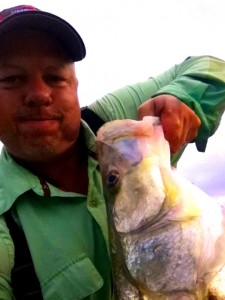
“PLOP”
I watched one of my last jigs disappear into the swirling green water I was standing in. It had slipped through my shaking fingers when I was retying after releasing the biggest snook I had ever caught. I should have been mad, but I just chuckled and barely even considered trying to recover it out of the thigh-deep water. Still thinking about the big snook, I pulled my jig box out of my pack and selected a similar model, and my fingers were still trembling a bit as I knotted it onto what was left of my 50 lb. shock leader. I had already landed several other snook of various sizes, and soon I would land several more, as well as break off a few other big ones, further eating into my dwindling supply of jigs. The bite had started to slow when I hooked a truly GIANT fish. After 5 minutes of back and forth I had a monster redfish at hand that had eaten a white bucktail jig I had tied myself. 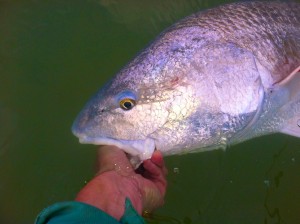 I’ve caught my share of redfish before, but this thing was so big it was like an entirely different kind of fish, easily over 20 lbs. After releasing the beast, I figured I had done enough damage for the morning with jigs, so I hooked the bucktail onto a guide and switched rods [not knowing at the time that a big snook would end up wearing that jig as a lip ring the next morning after wrapping me around a piling!]. I often bring two rods out with me on these sessions, usually one fly and one spinning. I decided it was a good time to get a few on flies. My session wrapped up with me putting a Stay Hungry Streamer to good use on a nine weight, catching 4 more snook, a ladyfish, and a 20” trout that came back to the condo with me.
I’ve caught my share of redfish before, but this thing was so big it was like an entirely different kind of fish, easily over 20 lbs. After releasing the beast, I figured I had done enough damage for the morning with jigs, so I hooked the bucktail onto a guide and switched rods [not knowing at the time that a big snook would end up wearing that jig as a lip ring the next morning after wrapping me around a piling!]. I often bring two rods out with me on these sessions, usually one fly and one spinning. I decided it was a good time to get a few on flies. My session wrapped up with me putting a Stay Hungry Streamer to good use on a nine weight, catching 4 more snook, a ladyfish, and a 20” trout that came back to the condo with me. 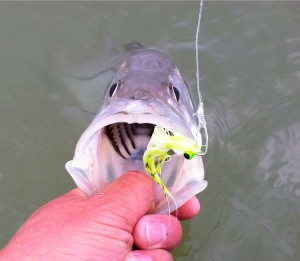
9:15 AM and I’m on the road back to the condo, AC cranked, music cranked. Alanis Morissette is telling me about things that are ironic, like rain on your wedding day. Well what about spending hundreds of dollars on a guide and catch practically nothing only to have one of the best fishing sessions of your life two days later on your own. Now that’s some black fly in your chardonnay shit there for sure.
This isn’t the first time I’ve pulled off something like this. I’ve been thinking about how many times I have found good fishing on my own in various saltwater locales. This is in no way meant to discourage you from going on a saltwater trip, or to not ever hire a guide. A day out with a guide is a great opportunity to pick someone’s brain who lives there. Besides giving general tips on tackle, flies and general mechanics of the fishing in the area, a good guide should be able to offer some insight on DIY spots. What the heck, I’m A GUIDE! BUT, I do encourage you to try and strike out on your own to find some great fishing on your own. It is almost always going to involve a little work, quite a bit of walking, and it may take a couple of days of eliminating water to find something good. But when it all comes together, the satisfaction level is far higher than you could get on a guided trip.
Most of the time when a person finds himself looking at the ocean, he didn’t go there just to fish. Chances are good that there was some family fun related reason to be where you ended up. Maybe there was a wedding or a business meeting. Whatever the case, if you find you’ll be near some salty water, consider striking out on your own, as there are almost certainly some DIY opportunities to be had. A person could plan a nice salt trip with no boat, [I have some good suggestions for this!]but this is more about searching out the best that your given area has to offer. I have had good fishing on my own in Texas, at the Baja, in Cancun, and in a few places in Florida.
This most recent trip was in the Ft Myers area of Florida, specifically on Sanibel Island, for a family vacation. We had this trip planned for nearly a year, and while I booked a day with a guide, hoping to finally hook AND land a big tarpon, I knew that due to the family vacation nature of the trip, as well as budgeting reasons, most of the fishing I would do would be in short sessions on my own.
The guide I had is someone I’ve been out with before, he’s fished the area for many years and knows the water well. We were going to spend part of the time looking for tarpon, then maybe tangle with some snook or reds in the afternoon. It wasn’t meant to be, and while we did see a lot of tarpon, I never had and chances to cast at any, and our later attempts at snook in mangroves were unsuccessful. I hooked one snook, and it was smaller than any of the 25 or so I caught on my own later. Maybe the fly fishing thing with a guide is over rated here. About 8 years ago I was out on a similar tarpon/snook adventure. Tarpon chances were non-existent, and snook could not be had on flies, although I did catch a few on bait. I went out a couple days later with my father in law in tow, he is not an angler at all. I had told the guide we wanted to do whatever would be EASY. This proved to be a good plan, as we caught a pile of fish of all descriptions, and I hooked an insanely giant tarpon on what I would consider to be a light walleye rod. A really great day of fishing, no fly fishing involved. This outing makes 6 attempts at a tarpon here, and the only one I’ve caught was a 30-pounder caught blind casting up a river.
Maybe I’m a shitty fly fisherman. While anything is possible, I do have a lot of evidence pointing to the contrary. Next time down here, I think I will just skip the tarpon on a fly thing, and save it for the Keys.
In the months leading up to the trip, I had plenty of time to dial in some good walk in/wade fishing spots on and around Sanibel. I had been there before, so I had some ideas. About ten years ago I got into a bunch of small snook casting streamers off the beach. This is a well know fishery that is super easy to pull off—provided the fish are there [right time of year] and the weather is cooperative [no giant waves]. So I had this to go on. The condo I was staying at had free kayaks to take out, so this was likely to offer some opportunities as well. I spent hours on Google Earth, looking at any possible access spot. I googled every combination words involving fishing on Sanibel—things like “Sanibel fishing, “Sanibel Snook”, Sanibel wade fishing”, “Sanibel surf fishing”, “Sanibel fly fishing”. These Google searches would reveal clues, leading me to posts on message boards, guide’s fishing reports, and blogs. I also searched these things on YouTube and Instagram. In my on-line searches, certain locales, techniques and info popped up regularly, and a couple of videos revealed some very specific spots I was able to locate on Google Earth. [Use “street view” if possible to have a ground level view of parking options]. Any spots or info that looked promising was logged and emailed to myself so I would have easy access to the data. By the time we got there, I had enough spots to keep me busy for far more time that I would have in 10 family vacations. As our trip approached, the weather was promising, very steady, and water temps in the Gulf were a month ahead of schedule. Communications with my guide indicated that tarpon were all over the place, so even that was looking promising. I studied the tide charts enough to trick myself into thinking I would actually be able to predict what the tide would be doing. Truth be told, I don’t think anyone, including the guides, know what the hell is going to happen with the tides. Every time I’ve ever had a guide he is always saying things like “The tide should be moving a lot more here” or “where did all the water go, low tide isn’t for another two hours!”
I planned ahead enough to ship via UPS my rod case [3 spinning rods, 3 fly rods] and a box of tackle, so that would all be waiting for me, and would allow me to bring somewhat more gear than if I was having to schlep it though airports.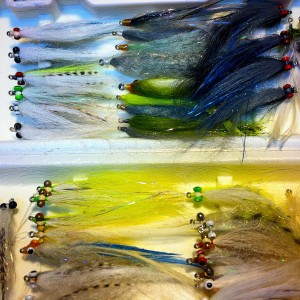
When it came time for exploring, I initially used some sightseeing missions with the family to scout out a couple of spots, noting parking spots, presence of other anglers, what the tide was doing, etc. The first time I fished my wife dropped me off at a canal I had identified through videos and Google Earth. I knew this spot was no secret, but the fact there was no parking available within a half mile greatly cut down on pressure. I put in 3 sessions at this spot during the week, caught fish every time, and never had any competition. Here I caught several snook and jack crevalle, as well as a couple of the very evil “leather jack”, a nice enough looking silvery fish, but with super sharp spines that have venom. One stabbed me and my finger was numb for an hour. I briefly explored an adjacent bay, cautiously wading along the edge of a mangrove shoreline, casting straight ahead. I was surprised to not catch anything here, because the water was very fishy, lots of bait, crabs, and mullet. An alligator popped up about 50 yards away from me once, but it just slowly swam away from me, heading in the direction I had come from. It didn’t look too big, so I didn’t worry about it. Much.
Being somewhat intrepid when it comes to exploring fishing spots, I am able to continue fishing when faced with perils such as gators, sharks, stingrays, and jellyfish. I continually tell myself how much more likely I am to get hurt on the car ride there than by any aquatic creatures. I do wear long pants or waders most of the time, I always have on long sleeves for sun protection, good footwear [cheap tennis shoes, throw them away after your trip], and a knife on my belt, just in case. If you are easily spooked by the thought of potentially dangerous critters, well consider just fishing off the beach, or sticking to the guided trips. One morning I was in almost to my waist when a big boil appeared about 50 feet in front of me. I was 50 yards from shore, so there was no sense in trying to get away from whatever it was. A few minutes later I was re rigging when the culprit, a big manatee, popped his head out ten feet from me. [Manatees are as harmless as a cow, hence their nickname, the “Sea Cow”].
The spot where I did the most damage was in an area easy to access and it is very well known. I gave it a try early one morning. I caught a small snook right away, missed a few other strikes and was contemplating a move. I was keeping my eye on another angler who had waded way out on a sandbar and was casting at some docks and mangroves. I never saw him hook a fish, but he passed me on the path while he was leaving and in a great “Boomhauer” type accent told me, “Tell you what man hooked three dang ol’ snook right up ‘er by that dang ol’ white dock…must be some kind dang ol’ hole up there, every time cast right up there bing bang boom, hooked three broke my dang ol’ line”. Figuring I won’t ever get a better tip than that, I checked the time and made a beeline to the sandbar. Besides, this was the same area that a friend had indicated may be a good spot to try. My time was running short, but I stuck three or four snook on jigs pretty quick, made the switch to flies and got a few more, plus a jack and a trout.
Other spots that I had scoped out were going to wait for another trip, as there was no way anything was going to top this spot. On my last morning some guide boats were working the area around me, it brought me great joy that I never saw one of them put a fish in the boat. I ended up putting in three morning sessions there, and caught at least 25 snook, lost and missed many others
There are some venues that lend themselves to fly fishing more than others, going forward I’ll be a little more selective about where and how I fish. As I’ve said many times before, lucky for me I like catching fish all different ways. There are places where the guides must really hate fly fishermen. One morning in the Baja as we were pulling away from the dock, our guide was talking and gesturing to a different guide in another boat. I had fly rods with me, and based on the tone of his voice and body language, he wasn’t telling the other guide “Oh this is going to be great, there’s no better way to catch fish down here than with a fly rod. We’ll have to quit early because the boat will be overflowing with fish by noon.” I think it was more like the Mexican version of “why me?” I did catch fish on flies that day. Trolling them.
But later on that same trip I caught various shallow water fish and had a couple of very good chances at roosterfish on my own casting flies off the beach.
When you strike out on your own, initial explorations are really best accomplished with a spinning rod. You can cover so much water so quickly compared to what you can do with a fly rod. By far and away the most important element in every kind of fishing on earth in LOCATION. Find the fish, once they are located, now you can dial in your presentation. If you prefer fly fishing, great. I know that is what I prefer to do when possible, but wind, water depth and other factors can make fly casting nothing more than casting practice [if it’s windy, it isn’t even that!]. What kinds of lures and flies you should have depends on where you will be and what kind of fish you’ll be after. I try to bring a little bit of everything, maybe check with a local tackle shop in the area for suggestions on both tackle AND on locations. Try to do your fishing when conditions are best, low tides allow anglers on foot better access to many spots, and mornings will usually find the fish more active. Also the winds will usually be lighter than in the afternoon.
Oh, and by the way, these tips can also help you find some new spots close to home too!
]]>
Are you out of fish to catch?
What’s left on your fly fishing bucket list? Steelhead, pike, striped bass? These are pretty simple, you could probably catch all 3 on one trip without a boat if you planned it right. How about things like tarpon, king salmon, muskie, sailfish, or other commonly pursued fly rod trophies? These are a little tougher, but still easily accomplished with minimal resources and a little time. What about marlin? Trevally? Taimen? How about a tigerfish? These are the kinds of fish that we’re talking about! Fish that really require a high level of commitment—both physical and financial. If you are seriously running out of fish to target on your next big trip, or just really want to have one up on your fishing buddies, have I got a trip for you!
What if you could target a trophy fish with a fly rod, that is still off everyone’s radar? It’s not going to be easy or cheap, but most things worthwhile aren’t. Success is far from guaranteed, your personal safety may be in danger the entire time, and the budget of this will surely exceed that of the last several trips you’ve gone on combined.
A hundred years ago, this fish was unknown to man. Many people have still not heard of it, very few have actually seen one, even fewer have actually caught one, and almost no one has caught one on a fly.
The fish we’re going after could only be one thing – the coelacanth.
“Aren’t those the prehistoric ‘missing link’ type fish only found in deep water off Africa” is what everyone says now. Yes they are prehistoric, and quite possibly are a missing link between primitive creatures and certain other animals. They do live in very deep water most of the time, but a select group of sportsmen from Africa has discovered times and places when these denizens of the deep come into range of sport fishermen. Sometimes WAY into range.
I had a chance, and very random conversation at a family function with a friend of a family member who told me the craziest fish story I had ever heard. As unbelievable as it was, I still found myself sending a letter [the paper kind] to a person on the other side of the globe. I got a response, and this led to a ton of research, me learning parts of 2 new languages, culminating in a 20,000 mile round trip journey involving almost every form of transportation you could think of, including a giant tortoise that hauled my gear at one point.
I sold one of my boats to help pay for the trip, sponsors paid for parts of the rest, and my generous hosts covered most of my expenses once there. Now, I am hosting a trip that will allow an obsessed and compulsive fly fisherman to accomplish what virtually no one has done before—coelacanth on a fly.
While these fish are well established as being denizens of very deep [100-500 meters, or 300 -1500 feet], it has recently be discovered that these fish actually come to shallows at certain times of the year. Remember, it wasn’t all that long ago when we knew nothing at all of this fish, and since the first specimen was caught by a commercial fisherman in 1938 off the coast of Africa, there have been populations confirmed in other locales. My research has even uncovered rumors of American subspecies of coelacanth, but that’s another story for another day.
At the far western fringe of the Seychelles in the Indian Ocean are a few very remote atolls that have the unique combination of a remote location, heavy environmental protection, and very specific habitat found virtually nowhere else on earth. These atolls are surrounded by very deep waters that are known to be the home of the aforementioned deep water coelacanths. The atolls we’re concerned with each consist of a ring of islands surrounding very large lagoons. These lagoons connect to the deep ocean through distinct channels that have a high volume of water moving through them when the tide changes. It is in these channels where things get really interesting. While my new friend and guide Captain Stuart Bing is still putting all of the pieces of the puzzle together, it is a fact that the C-los [that’s what we call them] come into and feed in these channels at certain times. It is believed that this strange occurrence revolves around a spawning ritual coinciding with a mass exodus of a local type of shrimp that call the lagoons home. During the biggest spring tides, these shrimp leave the lagoons by the thousands, and the C-los lie in wait in the channels, sometimes creating moonlit feeding frenzies that just cannot be believed. Yeah, I said moonlit, this is almost strictly a nighttime deal. These fish are very light sensitive, and it is at the time of the first full moon following the Perigean spring tide that this really gets going.
Timing on this trip is crucial. A week too early or too late could mean no fish. We have studied the movements of these fish compared to tides and moon phases for the past few years and are confident that our next trip will be right on as far as timing goes. During this moon phase, it is thought that they stage in semi deep water out from the channel mouths during the day. Then, the C-los move into these channels as the sun sets, and they seem to alternate between feeding and mating behavior. The shrimp come out of the lagoons on the outgoing tide, the reason for this we don’t know. We don’t see them coming back on an incoming, at least not in any huge numbers, so this must be a time when the shrimp just disperse to populate other areas. When the shrimp start moving, it is not long before the C-los come calling.
When the C-los are feeding, it creates a disturbance that is hard to believe. There is a lot of jaw snapping, thrashing, and splashing as they gulp down these shrimp by the dozen. Other C-los will hear this and join the melee, and before you know it you can have schools of C-los numbering in the hundreds tearing up the channel. When they are feeding this way, they viciously attack virtually everything we have cast at them that even vaguely resembles these 3 -5” long shrimp. Then, perhaps when they’ve eaten enough, the entire group of fish will cease feeding and begin this other behavior that is hard to describe. It is reminiscent of how tarpon form a “daisy chain”, except that they move in more or less a straight line, so instead of “daisy chaining”, we call it “crazy training”. If you are lucky enough to witness it, you’ll see how fitting this name is, as these huge fish follow behind one another, biting at each other, and sometimes sticking their heads out of the water and loudly snapping their jaws. You can actually hear their jaws snapping from nearly a mile away. They always move into the current, and it is always the biggest fish at the front of the train. The others will follow wherever their leader goes, and it often ends up looking like and incredibly long snake as the train sinuates up the channel. Sometimes an intrepid individual will make a move that allows him to cut ahead of the fish in front of him—it usually starts with the trailing fish clamping down on the next fish’s tail hard enough to get the front fish to spin around. This distraction allows the trailing fish to move up a place. Why it is desirable to move up in the train, we don’t know. While the C-los start “training”, trying to get them to bite has proven futile—they are just not interested in feeding, and we’ve tried various lures and even live shrimp to no avail. This is just as well, because if you were there for the frenzy, it is likely that you’ve had enough fish fighting for a night, now it is time to enjoy the show.
The moon will be full, or at least mostly full for the duration of the trip, and once you are used to it you can see surprisingly well. There is also considerable bio-luminescence occurring, adding to the bizarre scene. If the moon does not cooperate, we have developed some special lighting systems that not only allow us to observe these magnificent fish, but also seem to draw the shrimp to whichever part of the channel we have staked out in.
So, we’re fly fishing at night in one of the most remote areas on earth. An area known to have pirates, crocodiles, and huge sharks. Safety is a huge concern on these trips, and we have come up with multi-boat system that allows each angler to hook and land as many fish as is possible during a session. We fish from a Mother Ship that is anchored or staked out at a favorite spot in the channel.
As the night progresses, the fish move up closer to the lagoon, and it is sometimes necessary to make a move in the middle of a session. While the Mother Ship is large, the designated casting area is relatively small, allowing for two anglers to cast at a time. When a fish is hooked up, the angler is escorted into a smaller “chase boat” [captained by your personal guide/valet] allowing the angler to keep the fish close and land it in a reasonable amount of time. Once the fish is landed, the guide drives the boat back and ties off to the Mother Ship. The successful angler can take a break, enjoy a snack or beverage while he waits for his turn to come up again. In a typical night, each angler will hook up about 5 times with a fifty percent landing ratio. Safety is always a concern, as pirates, smugglers and other malfeasants are known to pass through this area. The Mother Ship has a fulltime security crew including a gunner with a 50 caliber fully automatic rifle. Your guide will always be armed with both a rifle and a sidearm, and the chase boat has emergency supplies should you become unable to return to the mother ship. On more than one occasion it had been necessary to wait until daylight to rescue a chase boat that ended up in the open ocean while pursuing their fish. GPS and beacons make this process relatively simple. When we picked up one angler, he proudly showed off his giant fly reel that had been stripped of the quarter mile of backing.
Your guide will be at your side from the time you get picked up in Madagascar until you are dropped off. He will act not only as your fishing guide, but as your valet, assisting you with anything you need every step of the way. These guides are very knowledgeable of the waters and surrounding islands, and are very familiar with the fish and wildlife, as well as local culture. These guides are still learning the nuances of sport fishing though, and may not be able to offer much help with technical fly fishing questions or rigging. If you are not able to select and rig your tackle, tie knots, or handle and unhook fish, then this trip is not for you.
As far as tackle goes, this is a trip for heavy gear. You will be provided with a complete list of tackle and gear required for the trip, and only approved rods and reels will be allowed when we are set up for C-los. We’ve had pretty good success with 12 weights, and any current model from a respected fly rod company should suit you well. There are not any rods lighter than a #12 that will be allowed. Some anglers prefer the added beef of a true big game rod, like a #14, and using a rod like this will reduce the fight time. Be sure to have a reel to match, packed with as much backing as you can fit on it. Remember, these fish average 50 lbs., and you will have chances every night at fish over 100. We have seen and hooked some true giants, fish that look every ounce of 200 pounds, and if you don’t want to end up on the wrong end of a rescue operation your tackle better be up to the task. There may be some opportunities for smaller gamefish like trevally or bonefish, so if you want to bring a few lighter outfits for these fish, that’s fine. Just make sure that you have at least 2 outfits that are a #12 or heavier.
You will be fishing at night, so items often associated with saltwater trips like sunblock and polarized sunglasses are less important than you might think, but still bring them. More important are good deck shoes, fish fighting gloves [batting gloves work well], the largest size Boga Grip, and a CO-2 inflatable life vest [we ask that you leave this on at all times]. If you have not done so already, consider getting a conceal/carry permit before the trip. You cannot bring your own firearm on the trip, but permit holders will be issued a side arm once we are on location.
In the months leading up to the trip, we we be having several get-togethers where we will go over rigging, flies, fly tying, and general discussions of tactics and the logistics of the trip. These meetings can be viewed via skype if you can’t make it. This trip is scheduled for spring of 2016, the complete itinerary and prices will be finalized in the summer of 2015.
I realize very well that this trip is not for everyone. For the truly adventurous angler, this is a trip that is unmatched. So unique is this trip that we will be accompanied by a crew from the Discovery Channel that will be compiling video for a two hour special scheduled to air during Shark Week of 2016.
If you would like to be on the mailing list for updates on this epic adventure, be sure to send me an email describing why you would like to go on this trip, be sure to describe your experience level and other trips you have been on. There is only room for eight anglers this time, depending on how this trip goes we expect to do a similar trip the following year that could allow for more anglers.
One more thing, be sure to let me know if you are up for some smallmouth bass or muskie fishing, we can catch lots of those much closer to home, using tackle you probably already have on water with virtually no pirates.
]]>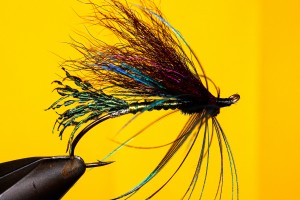 There was a time when I tied flies a lot. Almost every night in my smoky one room apartment you would find me drinking cheap beer and adding to my inexhaustible supply of flies. There were, and still are, certain flies that I can’t ever seem to have enough of—things like trout and steelhead nymphs or smallmouth poppers are good examples of flies that even today I need to keep after. But back then I worked at a fly shop, surrounded by the finest tying materials and hooks for most of my day. Since tying materials are pretty cheap, it was easy enough for me to constantly augment my supply of fur, feathers and synthetics. It was a pretty simple, yet enjoyable existence. The fun of tying more tarpon flies than 100 guys could use in a 100 years. I wish I had some pictures of the old apartment. I’m sure that it resembled a cross between a homeless shelter and a tackle shop. In fact one night a friend crashed on my floor, he complained the next morning that when he woke up he had rolled onto a pile of crankbaits.
There was a time when I tied flies a lot. Almost every night in my smoky one room apartment you would find me drinking cheap beer and adding to my inexhaustible supply of flies. There were, and still are, certain flies that I can’t ever seem to have enough of—things like trout and steelhead nymphs or smallmouth poppers are good examples of flies that even today I need to keep after. But back then I worked at a fly shop, surrounded by the finest tying materials and hooks for most of my day. Since tying materials are pretty cheap, it was easy enough for me to constantly augment my supply of fur, feathers and synthetics. It was a pretty simple, yet enjoyable existence. The fun of tying more tarpon flies than 100 guys could use in a 100 years. I wish I had some pictures of the old apartment. I’m sure that it resembled a cross between a homeless shelter and a tackle shop. In fact one night a friend crashed on my floor, he complained the next morning that when he woke up he had rolled onto a pile of crankbaits.
Somewhere along the way it appears that the smoky apartment has been replaced by a nice house, a wife and two kids have appeared, and the never ending 12 packs of cheap beer has been replaced by a couple of Summits. And while I still tie flies out of necessity, my nights of “recreational tying” are mostly a thing of the past. I now have a designated fly tying room, which makes it possible to get tying right away when the mood strikes.
Despite the thousands of flies I have tied, I still don’t consider myself to be a great tyer. If you need some durable, effective flies tied up in a hurry, then I’m your man. If you looking for a dozen that look just like the ones in the catalogs and on-line websites, please look elsewhere. I figured out at an early age that a simple scruffy fly will work just as well, and maybe better than an ultra-realistic fly, tied with jointed legs, antenna, eyes, genitalia, DNA sequencing, etc. Case in point—I was about 10 or 11, I’ve caught a whole lotta trout by this time in my life, but all on worms, a few on Mepps. My interest in catching a trout on a fly was strong though, and my grandpa would often rig up my Herter’s fly rod for me to flail away at rising trout with. One day I was working up a good froth at the bottom end of our favorite worm dunking hole, and much to everyone’s amazement, I ended up with a good sized trout on the line. The fly that I was using was one my grandpa called the “Black Nothing”, probably because it was just black fur on a hook. After the capture, he cleaned the trout streamside and showed me that it had several black beetles in its stomach. “That’s why it ate your black fly” he said, “it thought it was another one of these beetles”. Alright, black fur on a hook = beetle. Got it. I had simplified matching the hatch and flyting before it ever had a chance to get complicated on me.
So, combine that with my natural lack of artistic ability, and you’ve got a guy that is going to tie a fly that is good enough catch fish, but no better. In an hour, I can get well over a dozen of my scruffy specials done. On the other hand, someone who might be considered a “great” tyer, would probably be able to get half that many done. They would likely be perfect ties, but would they catch any more fish than the stuff I tie and fish with?
My friend JD “Redfern” LeCompte contacted me from his California ranch recently, letting me know he had an abundance of peacock feathers he had gleaned from their semi-tame flock, wondered if I could use them for fly tying. He sent a couple of pics of the plumage he had gathered, much of it was pretty standard tying stuff– eyed plumes and some swords, stuff that is easy to come by. But some of the feathers were stuff I had never seen before, and I wasn’t sure how I could use them. A week or so later I had an envelope in my mailbox that was overflowing with peacock. I was determined to set aside a night for “recreational tying”. 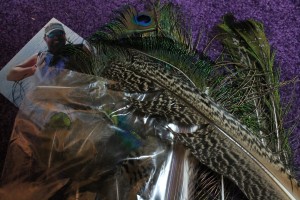
Once you start tying flies, you start looking at the world a little differently. As in “What could I tie with that?” every time you see a rug, a pet, a sweater, or fresh roadkill. An old girlfriend once forbid me to put a skunk tail in the trunk of her car [it only smelled a little—and the hair was really nice and long!], and I still have the tail of an albino squirrel that was dead in the middle of the road in downtown Farmington, Minnesota. Joe Vasquez was with me, we were running late for work on a Sunday after a morning mission to Hay Creek. When I first saw it on the centerline, I figured it was a cat, but as I passed it, nope, that’s a white squirrel—must have! I did a quick U-turn, pulled over and hacked the tail off with a dull knife. We still made it the Orvis store Downtown by 11. That tail is still in my collection.
In the package of peacock, there were some great looking body feathers that I suspected would be choice for tying “Spey” style flies. Spey flies are a traditional style of fly that still have a dedicated following. I’ve never tied very many, and I’ve certainly never fished with them, but they are very attractive. I was able to pull off a few “Spey” or “Spider” patterns that probably won’t see any time on the water, but will look really cool in one of my fly boxes dedicated to such things.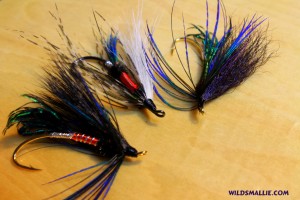
Peacock herl is very useful for tying trout and steelhead nymphs, and this stuff in the package was top notch. A few nymphs and a bugger for good measure will all go into a working box.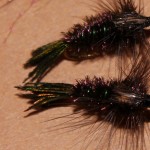
A popular “attractor” pattern here in the Midwest is the “Pass Lake”. It’s sort of a streamer/wet fly that doesn’t really look like anything, but on some days the trout can’t get enough of it. They are traditionally tied with black chenille for the body, but choice peacock herl works as good or better. The wing is supposed to be calf tail, these have the wing crafted of the aforementioned albino squirrel tail. I have always tied them with a red head. It’s fun to stray from my usual tying–only tying stuff I need. Maybe if I did this a little more I could actually become a good fly tyer.
It’s fun to stray from my usual tying–only tying stuff I need. Maybe if I did this a little more I could actually become a good fly tyer.
